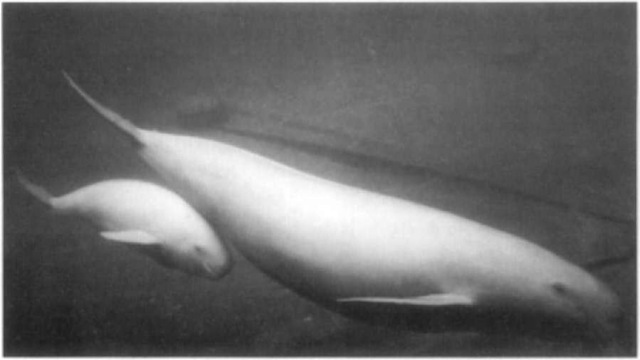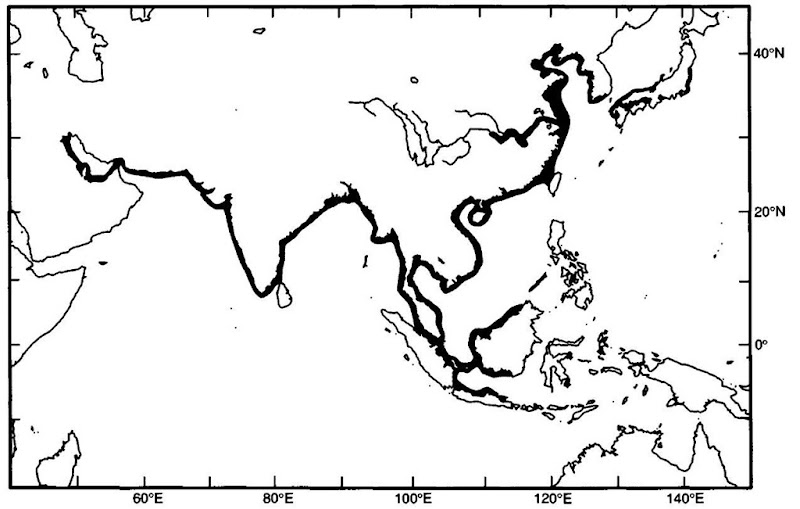I. Diagnostic Characters and Taxonomy
The finless porpoise is a small phocoenid cetacean lacking a dorsal fin as the common name suggests (Fig. 1). In* stead of a dorsal fin, a ridge runs down the middle of the back. The species has a rounded head without an apparent beak.
Figure 1 Mother and calf pair of Japanese finless porpoises in captivity
Its color is uniformly dark to pale gray and somewhat lighter on the ventral side. Teeth are spatulate as in other phocoenids.
The finless porpoise was originally described by G. Cuvier as Delphinus phocaenoides based on a skull supposedly from the Cape of Good Hope. However, there have been no further records of this species from the west coast of Africa and the true type locality is now considered to be the Indian coast. The genus names Neomeris, which is not valid since preoccupied by a polychaete, and Meomeris, which is a misspelled name and not available, were formerly used (Rice, 1999).
II. Distribution
Finless porpoises inhabit shallow coastal waters and some rivers in the Indo-Pacific region (Fig. 2). Their distributional range is from the Persian Gulf in the west, through the coasts of India, Indochina Peninsula, China, and Korea to northern Japan at the northern and eastern limit. The southernmost part of the range is the northern coast of Java.
Figure 2 Distributional range of the finless porpoise.
III. Geographic Variation and Subspecies
The external and skull features vary geographically, and three subspecies (originally described as different species), are recognized. They are Neophocaena phocaenoides phocaenoides for the form in the Indian Ocean through the South China Sea, N. p. asiaeorientalis for the Yangtze River form, and N. p. sunameri for that in the East China Sea, Yellow Sea, and off the coast of Korea through Japan. Although the discrete border of each form has not been elucidated, that between N. p. sunameri and N. p. phocaenoides seems to be in the southern East China Sea, where both forms have been observed.
Five local populations are clearly identified in Japanese waters based on skull morphology and mtDNA variability. Similarly, finless porpoises are considered to live in relatively small isolated local populations in other areas.
IV. Ecology
Finless porpoises prefer the mangrove zone in tropical waters. They are also found in estuaries and large river systems such as the Indus, Brahmaputra, and Yangtze Rivers. In the Yangtze River, finless porpoises are found up to 1600 km from the sea. In Japan, the habitat of the finless porpoise is strictly defined by depth (<50 m), distance from the shore (<5 km), and sandy or soft bottom. However, other reports indicate that proximity to shore is not necessarily important in the shallow East China Sea (Reeves et al., 1997).
Finless porpoises feed on various prey species from surface to bottom dwellers, including schooling fishes, squids, octopuses, shrimps and prawns, and they are considered to be opportunistic feeders. The only known predator aside from humans is the great white shark.
V. Behavior
Finless porpoises are observed year round in most localities, but seasonal fluctuation in density, suggesting some movements, has been reported in some areas.
Finless porpoises do not form large schools and are usually found in pairs. Kasuya (1999) concluded that a mother and calf or an adult pair is the basic social unit; the social structure seems to be undeveloped in this species. Usually, finless porpoises swim quietly and do not leap or make a splash. They tend to avoid vessels and do not bow ride, but they seem to be easy to observe in some areas, and commercial finless porpoise watching trips have begun in northern Kyushu, Japan.
VI. Morphology
The darkness and ontogenetic change of color pattern vary among subspecies. N. p. phocaenoides is born with lighter color and darkens with growth to be almost black as an adult (Parsons and Wang, 1998). However, neonates from Japan are black and lighten at 1 month after losing the fetal epidermis (Kasuya, 1999).
The dorsal ridge is also different among forms. N. p. asiaeorientalis and N. p. sunameri have a narrow and prominent ridge (a few centimeters in width), whereas the ridge of N. p. phocaenoides is wide and almost flat anteriorly (wider than 10 cm in adults). Horny tubercles are scattered on the ridge. Although they seem to be homologous to tubercles on the edge of the dorsal fin of other phocoenids, their function is not obvious. Some scientists have suggested that they function as an antislipping surface when mothers carry their calves on their back. It is more plausible that they serve as a sensory organ or organ for mutual contact, as many nerve endings occur in the tubercles (Kasuya, 1999).
VII. Life History
Finless porpoises grow to around 170 cm in length and 70 kg in weight, but animals over 200 cm and 100 kg have been reported. Size seems to be different geographically and generally larger in the northern population.
Information on reproduction is limited to that of porpoises from Japanese and Chinese waters. Animals from Kyushu live up to 25 years after sexual maturity at 4-9 years of age. The gestation period is estimated at around 11 months. The peak of the calving season is different among localities, i.e., April-May in the Yangtze River, May-June in the Seto Inland Sea and on the Pacific coast of Japan, and November-December in western Kyushu. Females are thought to calve every 2 years. The lactation period is estimated to be about 7 months, short as in other phocoenids.
VIII. Fossil Record
The only known fossil of Neophocaena is a skull raised from the bottom of the Seto Inland Sea, Japan. It is considered to be from the Late Pleistocene. There are conflicting views whether the finless porpoise is the most primitive or is derived of the phocoenids. A recent genetic study suggested that the species is the oldest lineage in the family.
IX. Interaction with Humans
Because of the nearshore habitat, the finless porpoise tends to be threatened by many human activities. Although there is no fishery that takes finless porpoises directly, incidental catches, mainly by gillnets, occur throughout the range. Habitat degradation by land reclamation and deforestation of mangrove area may be serious problems. Moreover, very high accumulation levels of toxic organochlorine and butyltin compounds have been reported from Japanese finless porpoises.
The distribution seems to be separated into relatively small local populations by unsuitable habitats of deep water or rocky bottoms. Such local populations are easily depleted, bringing about the decline of gene flow and genetic diversity of the populations.
Despite these concerns, our ability to measure the current status and population trend of the species is very limited. Relatively reliable abundance estimates have been obtained for only three populations in Japan. Recent sighting and questionnaire surveys in the Seto Inland Sea, which is a major habitat of the finless porpoise in Japan, indicated a decrease in abundance of the species. It is evident that prompt and intensive research efforts on every aspect of life of the species is required.


